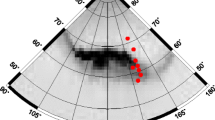Abstract
The possibilities of determining arbitrary current loop parameters based on the spatial structures of the magnetic field components generated by this loop on a sphere with a specified radius have been considered with the use of models. The model parameters were selected such that anomalies created by current loops on a sphere with a radius of 6378 km would be comparable in value with the different-scale anomalies of the observed main geomagnetic field (MGF). The least squares method was used to solve the inverse problem. Estimates close to the specified values were obtained for all current loop parameters except the current strength and radius. The radius determination error can reach ±120 km; at the same time, the magnetic moment value is determined with an accuracy of ±1%. The resolvability of the current force and radius can to a certain degree be improved by decreasing the observation sphere radius such that the ratio of the source distance to the current loop radius would be at least smaller than eight, which can be difficult to reach when modeling MGF.
Similar content being viewed by others
References
Alldredge LR. Circular current loops, magnetic dipoles and spherical harmonic analyses, J. Geomagn. Geoelectr., 1980, vol. 32, no. 6, pp. 357–364.
Alldredge, L.R., Current loops fitting to geomagnetic model spherical harmonic coefficients, J. Geomagn. Geoelectr., 1987, vol. 39, no. 5, pp. 271–296.
Alldredge, L.R. and Hurwitz, L., Radial dipoles as the sources of the Earth’s main magnetic field, J. Geophys. Res., 1964, vol. 69, pp. 2631–2640.
Alldredge, L.R. and Stearns, C.O., Dipole model of the sources of the Earth’s magnetic field and secular change, J. Geophys. Res., 1969, vol. 74, pp. 6583–6593.
Bochev, A.Z., The Earth’s magnetic field represented as dipoles, C. R. Acad. Bulg. Sci., 1965, vol. 18, pp. 319–322.
Bochev, A.Z., Two and three dipoles approximating the Earth’s main magnetic field, Pure Appl. Geophys., 1969, vol. 79, pp. 29–34.
Bochev, A.Z., Presenting the Earth’s magnetic field as a field of six optimal dipoles, C. R. Acad. Bulg. Sci., 1975, vol. 28, no. 4, pp. 469–471.
Demina, I.M. and Farafonova, Yu.G., Dipole model of the main geomagnetic field in the 20th century, Geomagn. Aeron. (Engl. Transl.), 2004, vol. 44, no. 4, pp. 521–525.
Demina, I.M., Nikitina, L.V., and Farafonova, Yu.G., Secular variations in the main geomagnetic field within the scope of the dynamic model of field sources, Geomagn. Aeron. (Engl. Transl.), 2008, vol. 48, no. 4, pp. 542–550.
Demina, I.M., Koroleva, T.Yu., and Farafonova, Yu.G., Anomalies in the secular variations in the main geomagnetic field in the context of the hierarchic dipole model, Geomagn. Aeron. (Engl. Transl.), 2008, vol. 48, no. 6, pp. 812–821.
Himmelblau, D., Applied Nonlinear Programming New York: McGraw-Hill, 1972; Moscow: Mir, 1975.
Kas’yanenko, L.G., Demina, I.M., and Sas-Uhrynovski, A., Representation of the Earth’s main magnetic field as a set of optimally oriented and located dipoles, Geomagn. Aeron. (Engl. Transl.), 2002, vol. 42, no. 6, pp. 801–807.
Knoepfel, H.E., Magnetic Fields. A Comprehensive Theoretical Treatise for Practical Use, New York: Wiley, 2000.
Mayhew, M.A. and Estes, R.H., Equivalent source modeling of the core magnetic field using Magsat data, J. Geomagn. Geoelectr., 1983, vol. 35, no. 4, pp. 119–130.
McNish, A.G., Physical representations of the geomagnetic field, Trans. Am. Geophys. Union, 1940, vol. 21, pp. 287–291.
Nevanlinna, H., Interpreting regional geomagnetic anomalies and their secular variation with the aid of radial dipoles and current loops, J. Geomagn. Geoelectr., 1980, vol. 32, no. 8, pp. 483–506.
Peddie, N.W., Current loop models of the Earth’s magnetic field, J. Geophys. Res., 1979, vol. 84, pp. 4517–4523.
Stump D.R. and Pollack, G.L., A current sheet model for the Earth’s magnetic field, Am. J. Phys, 1998, vol. 66, pp. 802–810.
Yukutake, T. and Tachinaka, H., The non-dipole part of the Earth’s magnetic field, Bull. Earthquake Res. Inst., Univ. Tokyo, 1968, vol. 46, no. 5, pp. 1027–1074.
Zidarov, D.P., Earth’s magnetic field modelling and Earth’s structure and evolution, Phys. Earth Planet. Int., 1985, vol. 37, pp. 74–86.
Zidarov, D. and Bochev, A., Representation of secular variations in the Earth’s magnetic field as a change in the field of optimal geomagnetic dipoles, Geomagn. Aeron., 1969, vol. 9, no. 2, pp. 315–320.
Zidarov, D. and Petrova, T., Representation of the Earth’s magnetic field as a field of a circular loop, C. R. Acad. Bulg. Sci., 1974, vol. 27, pp. 203–206.
Author information
Authors and Affiliations
Corresponding author
Additional information
Original Russian Text © I.M. Demina, Yu.G. Farafonova, 2016, published in Geomagnetizm i Aeronomiya, 2016, Vol. 56, No. 4, pp. 445–456.
Rights and permissions
About this article
Cite this article
Demina, I.M., Farafonova, Y.G. Inverse problem for the current loop model: Possibilities and restrictions. Geomagn. Aeron. 56, 415–425 (2016). https://doi.org/10.1134/S0016793216030038
Received:
Published:
Issue Date:
DOI: https://doi.org/10.1134/S0016793216030038




